Abstract
A family study was carried out to clarify the problem of two separate muscle disease phenotypes in a large consanguineous pedigree. These were a severe limb-girdle type muscular dystrophy and a mild late onset distal myopathy. Thirty-two first degree and 14 other relatives of 18 previously examined index patients were available for clinical examination. Twenty-three subjects underwent computed tomography of the lower leg muscles. No new cases of limb-girdle type muscular dystrophy were found. Distal myopathy was diagnosed in 14 subjects, 10 first degree relatives and four other relatives. Segregation analysis showed that the corrected proportion of affected with the severe proximal type was 0.246 and the proportion of affected with the distal myopathy was 0.58. Pedigree analysis is compatible with the possibility that the mild, late onset distal myopathy is caused by a dominant gene and that the limb-girdle type may be expressed in homozygotes.
Full text
PDF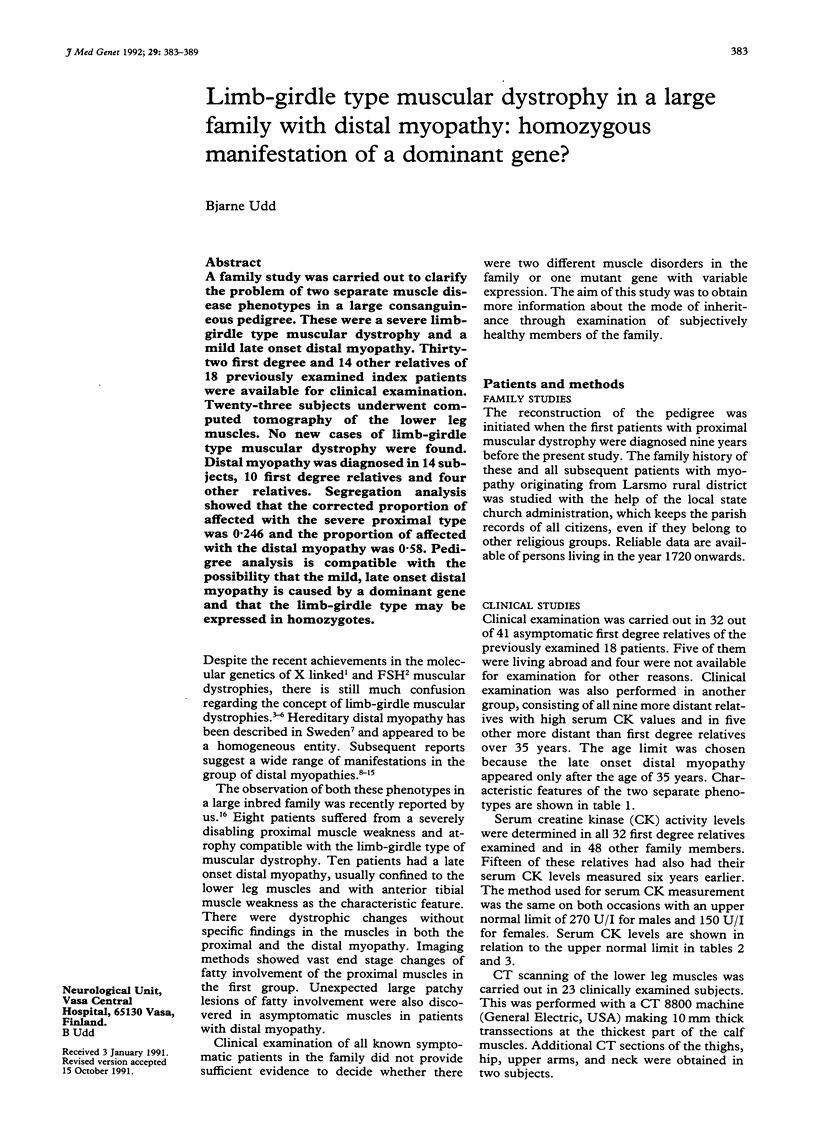

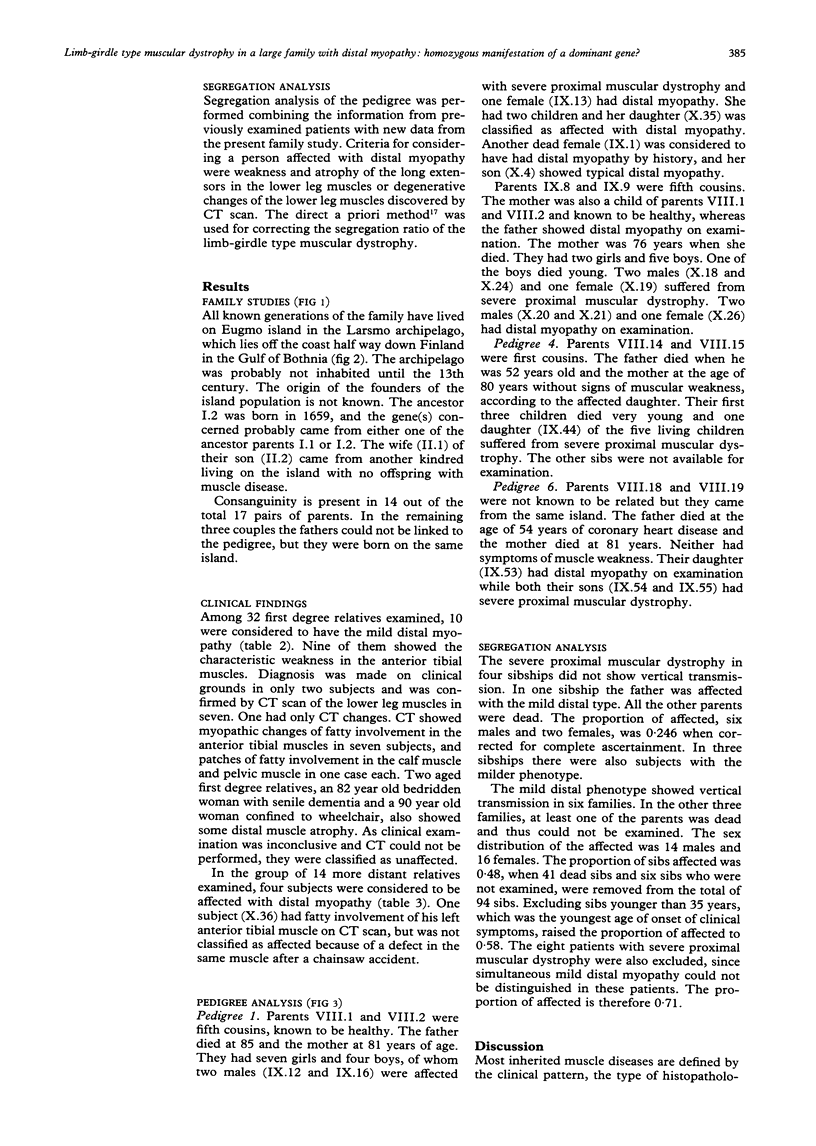
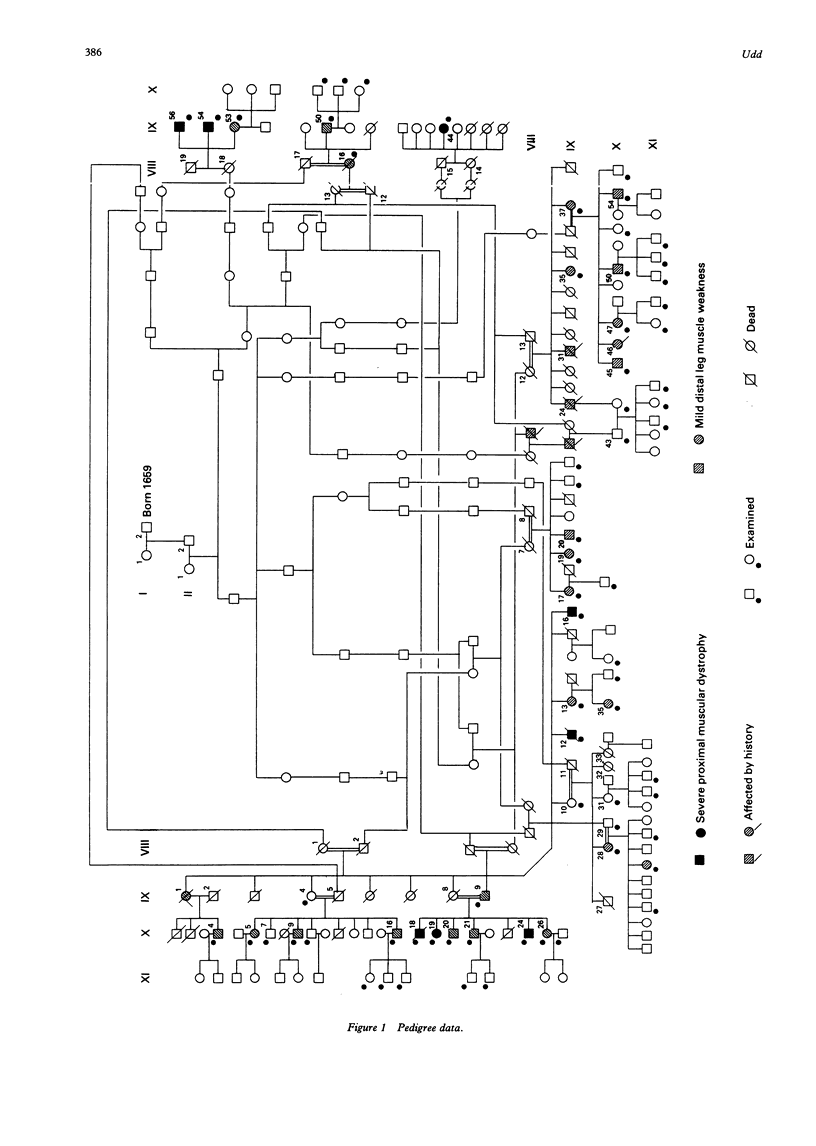
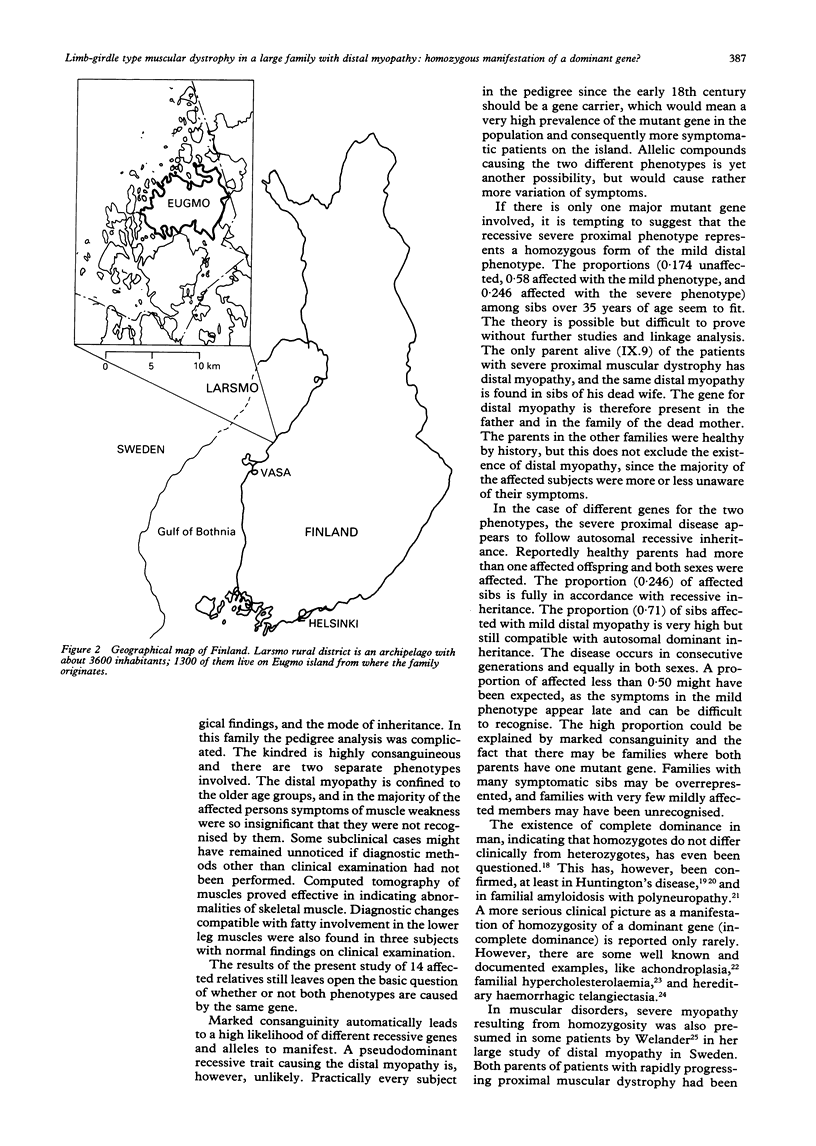
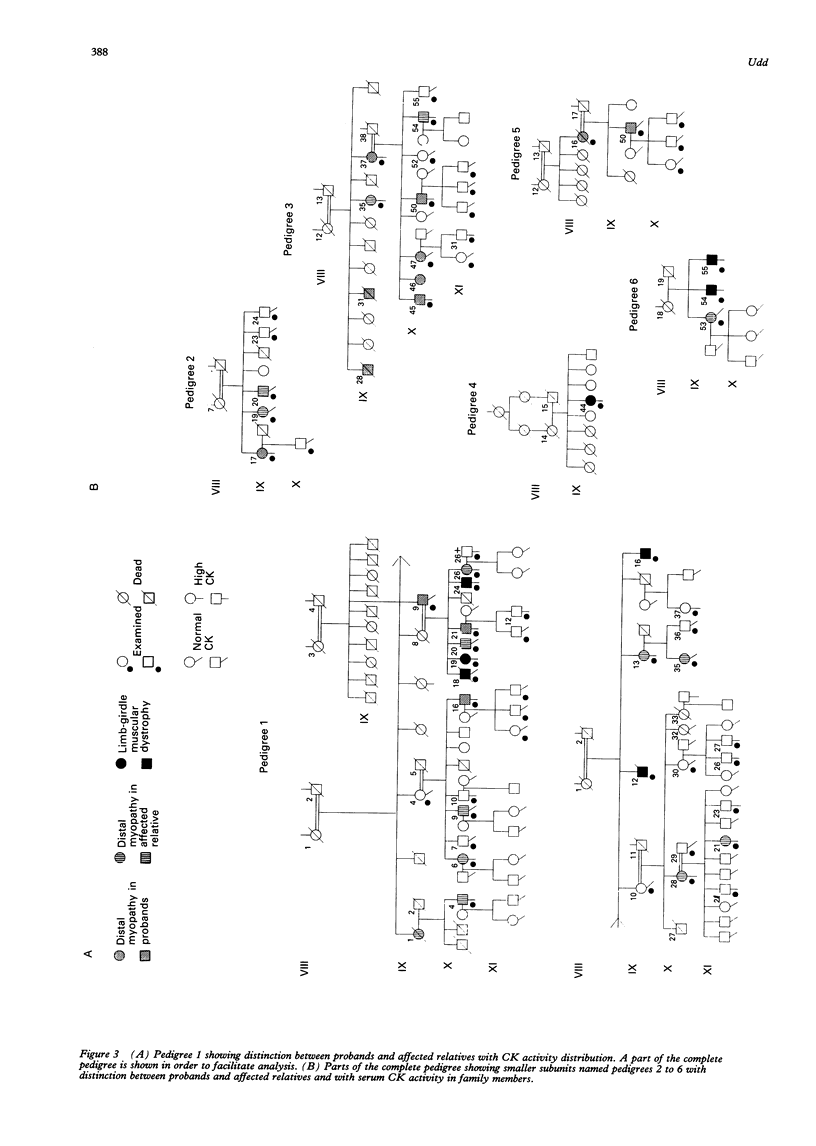
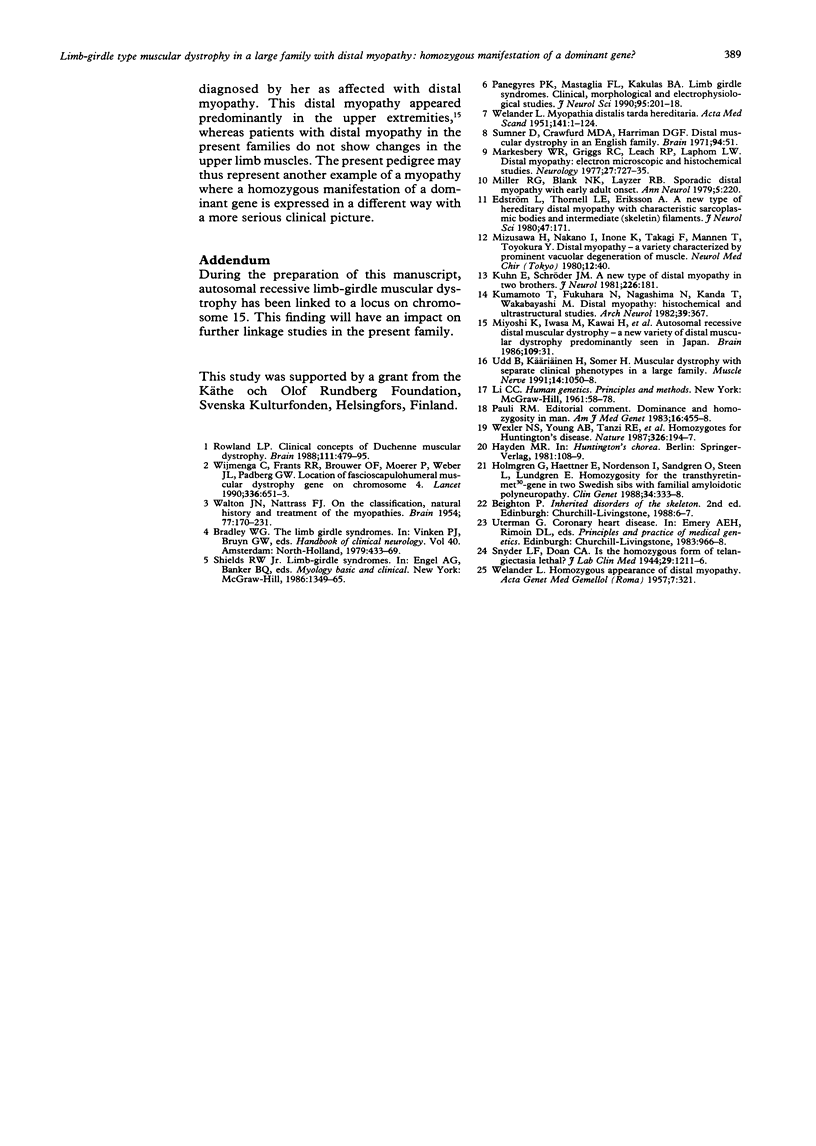
Selected References
These references are in PubMed. This may not be the complete list of references from this article.
- Edström L., Thornell L. E., Eriksson A. A new type of hereditary distal myopathy with characteristic sarcoplasmic bodies and intermediate (skeletin) filaments. J Neurol Sci. 1980 Aug;47(2):171–190. doi: 10.1016/0022-510x(80)90002-7. [DOI] [PubMed] [Google Scholar]
- GISSI-2: a factorial randomised trial of alteplase versus streptokinase and heparin versus no heparin among 12,490 patients with acute myocardial infarction. Gruppo Italiano per lo Studio della Sopravvivenza nell'Infarto Miocardico. Lancet. 1990 Jul 14;336(8707):65–71. [PubMed] [Google Scholar]
- Holmgren G., Haettner E., Nordenson I., Sandgren O., Steen L., Lundgren E. Homozygosity for the transthyretin-met30-gene in two Swedish sibs with familial amyloidotic polyneuropathy. Clin Genet. 1988 Nov;34(5):333–338. doi: 10.1111/j.1399-0004.1988.tb02887.x. [DOI] [PubMed] [Google Scholar]
- Kuhn E., Schröder J. M. A new type of distal myopathy in two brothers. J Neurol. 1981;226(3):181–185. doi: 10.1007/BF00313379. [DOI] [PubMed] [Google Scholar]
- Kumamoto T., Fukuhara N., Nagashima M., Kanda T., Wakabayashi M. Distal myopathy: histochemical and ultrastructural studies. Arch Neurol. 1982 Jun;39(6):367–371. doi: 10.1001/archneur.1982.00510180045011. [DOI] [PubMed] [Google Scholar]
- Markesbery W. R., Griggs R. C., Herr B. Distal myopathy: electron microscopic and histochemical studies. Neurology. 1977 Aug;27(8):727–735. doi: 10.1212/wnl.27.8.727. [DOI] [PubMed] [Google Scholar]
- Miller R. G., Blank N. K., Layzer R. B. Sporadic distal myopathy with early adult onset. Ann Neurol. 1979 Mar;5(3):220–227. doi: 10.1002/ana.410050303. [DOI] [PubMed] [Google Scholar]
- Miyoshi K., Kawai H., Iwasa M., Kusaka K., Nishino H. Autosomal recessive distal muscular dystrophy as a new type of progressive muscular dystrophy. Seventeen cases in eight families including an autopsied case. Brain. 1986 Feb;109(Pt 1):31–54. doi: 10.1093/brain/109.1.31. [DOI] [PubMed] [Google Scholar]
- Panegyres P. K., Mastaglia F. L., Kakulas B. A. Limb girdle syndromes. Clinical, morphological and electrophysiological studies. J Neurol Sci. 1990 Feb;95(2):201–218. doi: 10.1016/0022-510x(90)90243-g. [DOI] [PubMed] [Google Scholar]
- Pauli R. M. Dominance and homozygosity in man. Am J Med Genet. 1983 Dec;16(4):455–458. doi: 10.1002/ajmg.1320160403. [DOI] [PubMed] [Google Scholar]
- Rowland L. P. Clinical concepts of Duchenne muscular dystrophy. The impact of molecular genetics. Brain. 1988 Jun;111(Pt 3):479–495. doi: 10.1093/brain/111.3.479. [DOI] [PubMed] [Google Scholar]
- Sumner D., Crawfurd M. D., Harriman D. G. Distal muscular dystrophy in an English family. Brain. 1971;94(1):51–60. doi: 10.1093/brain/94.1.51. [DOI] [PubMed] [Google Scholar]
- Udd B., Käriänen H., Somer H. Muscular dystrophy with separate clinical phenotypes in a large family. Muscle Nerve. 1991 Nov;14(11):1050–1058. doi: 10.1002/mus.880141103. [DOI] [PubMed] [Google Scholar]
- WALTON J. N., NATTRASS F. J. On the classification, natural history and treatment of the myopathies. Brain. 1954;77(2):169–231. doi: 10.1093/brain/77.2.169. [DOI] [PubMed] [Google Scholar]
- WELANDER L. Homozygous appearance of distal myopathy. Acta Genet Stat Med. 1957;7(2):321–325. doi: 10.1159/000150998. [DOI] [PubMed] [Google Scholar]
- WELANDER L. Myopathia distalis tarda hereditaria; 249 examined cases in 72 pedigrees. Acta Med Scand Suppl. 1951;265:1–124. [PubMed] [Google Scholar]
- Wexler N. S., Young A. B., Tanzi R. E., Travers H., Starosta-Rubinstein S., Penney J. B., Snodgrass S. R., Shoulson I., Gomez F., Ramos Arroyo M. A. Homozygotes for Huntington's disease. Nature. 1987 Mar 12;326(6109):194–197. doi: 10.1038/326194a0. [DOI] [PubMed] [Google Scholar]


